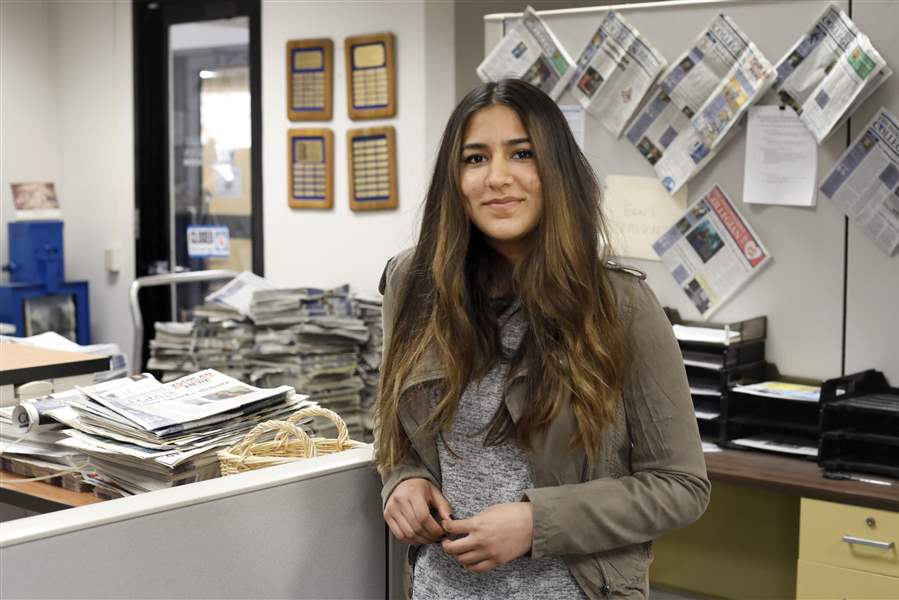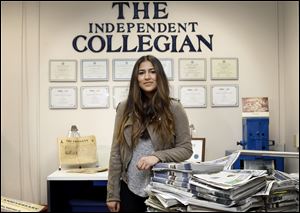
UT newspaper in danger of closing
4/15/2018
Areeba Shah is the Editor in chief of the University of Toledo's student newspaper The Independent Collegian. The weekly paper is pushing its focus to community engagement and digital production as advertising revenue continues to fall for it and other print publications. THE BLADE/KATIE RAUSCH
The Blade/Katie Rausch
Buy This Image
Believe it or not, newspapers are not in the practice of putting their opinions on the front page. Opinion is typically saved for inside pages, with rare exceptions made for matters of grave importance.

Areeba Shah is the Editor in chief of the University of Toledo's student newspaper The Independent Collegian. The weekly paper is pushing its focus to community engagement and digital production as advertising revenue continues to fall for it and other print publications. THE BLADE/KATIE RAUSCH
The Independent Collegian, the newspaper staffed entirely by University of Toledo students, published a front-page editorial this month, ominously headlined “Our newspaper is dying.” That shows how serious the financial problems are at the newspaper, editor-in-chief Areeba Shah said.
“Within the past five years, we’ve been noticing a steady decline in ad revenues,” Ms. Shah, a junior at UT, said. “This is something that we’ve thought about in the past, but now something needs to be done.”
The paper stopped paying its student workers mid-semester and will cut its print production to every other week next year in an attempt to right the newspaper’s finances, which are falling victim to a familiar narrative of newspaper decline.
Ad revenue is declining, faculty adviser Erin Gariepy said, and the turnover present on any college newspaper makes that problem harder to tackle. The advertising manager for next year is already set, she said, which helps give the publication the stability it needs to start turning its finances around.
“Our issues are pretty much covered for the rest of the year,” Mrs. Gariepy said. “I’m hoping to use the whole summer to secure more donations, secure those sponsorships, and have ad contracts signed to take that pressure off.”
The paper is aggressively seeking new advertisers and fund-raising opportunities, starting with a $1,500 Kickstarter campaign and on-campus events like a recent forum on race, diversity, and inclusion that aim to make the paper and its work more relevant to students on campus.
“We had a lot of students come to our event, offer us support, and then they ended up going to our Chipotle fund-raiser,” Ms. Shah said. “We’re really getting involved more with the community and helping them understand that we have more to offer than our print newspaper.”
That Kickstarter campaign ends April 20, and is an all-or-nothing goal, meaning the newspaper only gets the donations if the goal is met.
“We had to shoot for something that was a small goal,” Ms. Shah said. “People were asking how can we help, how can we donate, so we had to do something that would encourage people to donate.”
The reduced print schedule means a heavier digital focus, though a fresh edition will still be designed weekly and published electronically. The paper is the primary way UT students learn print journalism, Mrs. Gariepy said, so she did not want to see page designers losing half of their education for financial reasons.
“It’s a one-stop shop for a lot of students to come and get a valuable experience on campus,” she said of the roughly 50 students who work for the Independent Collegian.
The paper explored different avenues of tapping into UT’s revenues to help bolster its own, but a statewide tuition freeze ruled out the kind of student fee independent college papers have come to rely on for stable funding.
BG Falcon Media, for example, brings in roughly $200,000 from a $9 per semester student fee, which supplements the student multimedia group’s ad revenues, which fall between $220,000 and $240,000 per year, Robert Bortel, the director of student media, said. The group, which is editorially independent but operates within the university, previously brought in nearly $1 million in ad revenue in the late 1990s.
“It’s not like we’re insulated from what’s happening in the industry,” he said. The full-time staff he oversees has been cut in half, and the paper is down to printing only two days per week.
He said the Independent Collegian is in a tough spot in part because, unlike Bowling Green State University, print journalism is not a prominent program at the college.
“Toledo didn’t have a real critical mass,” he said.
Contact Zack Lemon at zlemon@theblade.com, 419-724-6282 or on Twitter @zack_lemon.